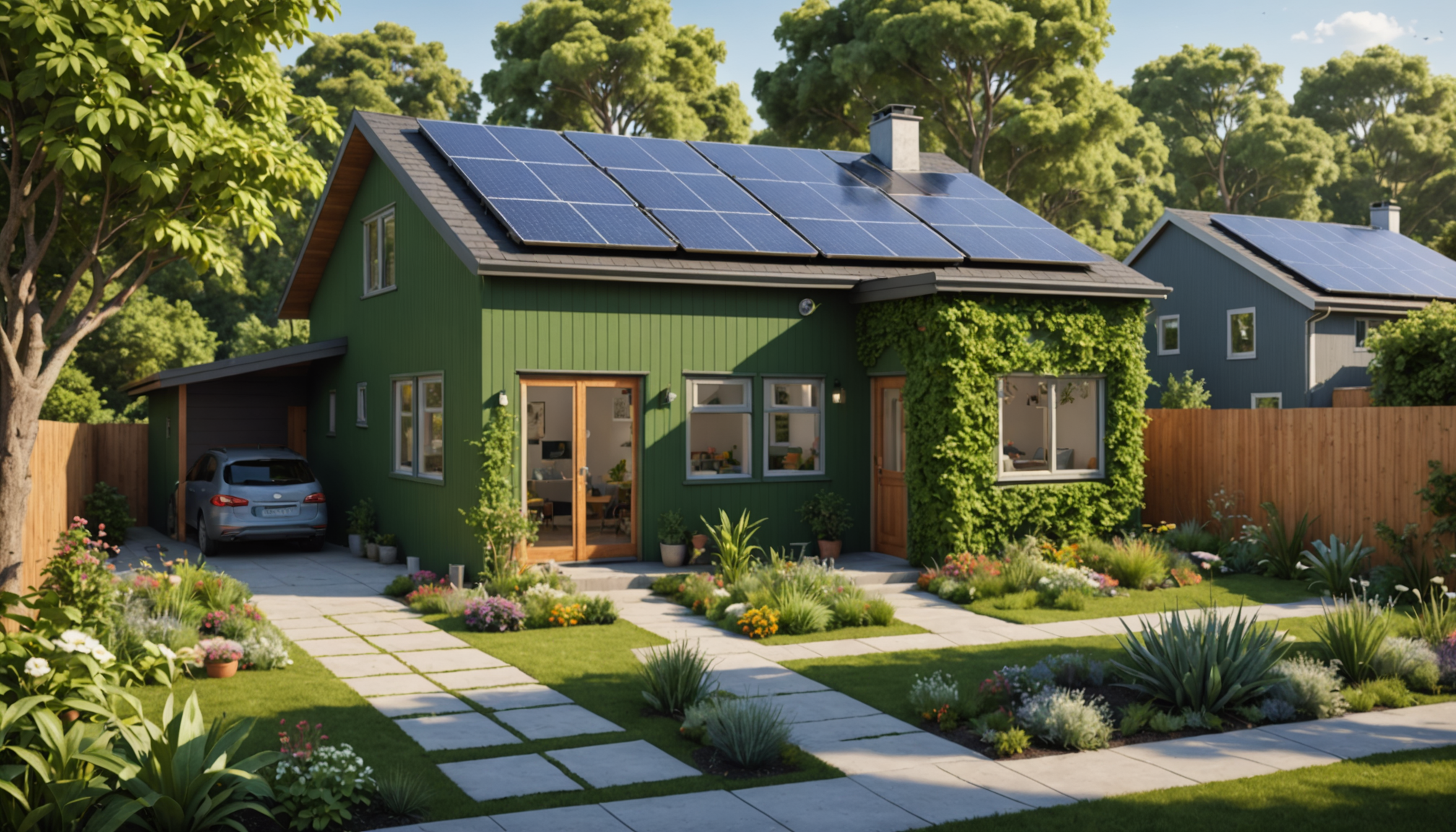L’autre jour, alors que je venais de terminer un atelier sur l’upcycling, je me suis retrouvé à discuter avec un couple de participants. Ils venaient d’acheter une maison des années 80 et se demandaient s’il était possible de la rendre plus écologique sans tout casser. Ça m’a rappelé mes premiers projets de rénovation écolo, quand je pensais que faire du neuf avec du vieux était mission impossible. Pourtant, en combinant techniques de récup’ et innovation, j’avais réussi à transformer des espaces autrement voués à l’obsolescence en lieux à la fois confortables et durables. Franchement, aujourd’hui avec toutes les solutions disponibles, c’est carrément faisable ! Ce que je vais faire, c’est partager ici les pistes que j’ai explorées et les astuces qui fonctionnent vraiment pour rendre une maison verte.
Isolation écologique : Première étape essentielle vers une maison verte
Quand j’ai commencé à travailler dans la menuiserie éco-responsable, je me souviens avoir été frappé par l’impact énorme de l’isolation sur la performance énergétique d’un bâtiment. Pour les maisons existantes, c’est un peu la clé de voûte de toute transformation écologique réussie. Un ancien stagiaire m’a un jour confié que sa facture de chauffage avait été réduite de moitié après une isolation performante. Cela montre à quel point c’est crucial.
Bon alors, vous vous demandez sûrement par où commencer. Pour être honnête, la priorité va à l’isolation du toit et des combles. J’ai souvent vu des maisons où cette étape avait été négligée, et franchement, les pertes de chaleur y sont immenses. Pour bien faire, utilisez des matériaux naturels comme la laine de bois, le chanvre ou même la ouate de cellulose. Non seulement ils sont plus écologiques que les matériaux traditionnels, mais ils offrent également une isolation acoustique supérieure. C’est du costaud !
Au fait, si vous doutez de l’efficacité de ces solutions, sachez que des marques comme Isole Plus et Isover proposent des produits qui, selon les retours d’utilisateurs, tiennent vraiment la route. Mes 25K abonnés sur les réseaux sociaux le confirment sans hésiter. D’ailleurs, un de mes meubles préférés a été restauré avec des chutes d’isolants récupérées à la casse. Oui, rien ne se perd dans la récup’, tout se transforme !
Petit retour d’expérience : lors d’une rénovation dans une ancienne maison à Villeurbanne, j’ai tenté une isolation par l’extérieur avec des panneaux en fibre de bois recouverts d’un enduit à la chaux. Eh bien, l’esthétique était nickel, et les performances thermiques ont surpassé toutes mes attentes. Que ce soit pour un esthétisme naturel ou pour la durabilité, c’était un succès !
Optimiser les fenêtres et préserver la chaleur
Let me tell you about something that tends to be overlooked in home renovations: windows. These are the real gateways to energy efficiency. Believe it or not, old windows can turn your home into an energy sink. Typically, if you live in a pre-1980s home, upgrading to double or triple glazing is almost non-negotiable. This makes a tangible difference in both winter warmth and summer coolness. Thermal insulators like Velux windows, known for their performance, and their functionality are also a fantastic choice.
For those who are still hesitant about the budget, let me remind you that there are government incentives available. I usually recommend visiting the local administration’s website to see which aides are applicable. Furthermore, brands like Hellio and Thermor often provide solutions that don’t break the bank but perform exceptionally well in energy savings.
That said, don’t forget that using curtains or blinds can also greatly enhance window efficiency by buffering against heat loss and appropriately cooling the space. It’s as simple as hanging thicker curtains in winter, as I learned on my balcony at Villeurbanne!
Rénovation intérieure : Combiner beauté et écologie
The inside of your home deserves just as much attention when it comes to eco-friendliness. While I was managing the local resource center, I learned that floors, walls, and even ceilings could be modified to naturally regulate temperature, moisture, and sound. To those of you who underestimate this step, let me reassure you that even paint can impact your home’s green factor.
I recommend avoiding products containing VOCs—those pesky volatile organic compounds. Instead, use eco-friendly paints. Some favorites among DIY eco-renovators are the products with beautiful, lasting shades by Quelle Energie and Aldes, and they emit far fewer pollutants than traditional paints.
Likewise, apply natural wax or oil coatings to bare wood surfaces. During a project with an antique store patron, I successfully restored a floor using a blend of linseed oil and beeswax that provided a durable and lush finish. It’s the kind of upgrade that works miracles not just for your health but for the planet as well.
In terms of flooring, bamboo and reclaimed wood are popular choices and for good reason. They marry style, sustainability, and strength. I’m sure you’ll find that these alternatives, much like the library that went viral with 50,000 views, are both in-demand and impactful!
Efficient heating and ventilation
Let’s not forget about heating and ventilation. I’ve long held the belief that this is an area worth investing in. Simply put, an efficient heating system is indispensable, especially given that our winters seem to get harsher every year.
Brands like Atlantic and Thermor offer systems that pack a punch for both warmth and budget efficiency. Coupling these with an intelligent ventilation system like those offered by Hellio lets you optimize indoor air while lowering energy costs. Plus, you have to ensure you abide by modern regulations surrounding ventilation systems. You can find more details on this from sources like Service Public.
I personally advise installing thermally conductive flooring in heated areas, one such system that’s been gaining popularity is the floor heating panels with aluminum foil. It’s highly effective at distributing heat evenly, so your toes won’t be fighting for heat supremacy during frigid days.
Énergies renouvelables : un choix responsable pour la maison
The flicker of renewable energy isn’t just wishful thinking any longer. Many households, wishing to lessen their carbon footprint as I did, opt for renewable energy. A good place to start? Photovoltaic panels. They’re more accessible than ever, with providers installing systems with payment plans to accommodate your pocket. Not to leave out, programs like Quelle Energie frequently offer substantial rebates to further encourage this green transition.
Thanks to technological advancements, today’s solutions include thermal solar systems and wind turbines powerful enough to handle moderate energy needs. Additionally, given how weather-dependent solar can be, it’s recommended that you aim to hybridize energy approaches when possible. This way, you’ll have a backup for when the unpredictable French skies decide to act up, guaranteeing access to clean energies round the clock.
Remember, though, these installations need to meet local regulations. It’s wise to consult resources like Artisanatura to ensure compliance with these guidelines.
Les bons réflexes réguliers si votre maison est déjà verte
Even a green home requires periodic maintenance to stay efficient. Indeed, preventative measures and routine check-ups ensure your home remains a paragon of ecological living. For those invested in DIY and self-managed home solutions, ensure filtration systems for water come aboard. They are a boon to both health and planet-saving endeavors. And, coincidently, these systems are often part of the housing directives I engage in during eco-meetups.
Moreover, keeping tabs on energy consumption fosters ongoing savings. An excellent starter pack involves shifting to low-energy appliances. While you might be skeptical, remember that appliances with a high energy rating typically witness a drop in energy usage by roughly 30%. The Energy Star program remains a faithful guide for those seeking assistance with product selection.
- Implement regular audits to detect inefficiencies.
- Engage more in community green programs.
- Integrate smart technology to ensure real-time resource monitoring.
- Seek alternatives for excess food waste and composting.
Prospective et anticipation pour les maisons de demain
It’s undeniable—the concept of tomorrow’s home is continuously being redefined. During a recent fair focused on sustainable tech, I was no longer surprised to find ambitious projects capable of propelling homes into new echelons of green efficiency. A prime player in this endeavour is AI technology, boasting better resource management and predicting users’ energy behaviors. One day, AI systems might operate between perchings of self-managed circuits and self-repairing walls using algae martrices—mark my words, future homeowners lucked out on foreseeability!
For those of you wanting to ensure your very home slots into future paradigms, anticipate the adoption of evolving biophilic designs. This intends to bring nature indoors, interrupting no part of natural habitation. Take for instance the popular integration of indoor green panels that juxtapose with indoor décor to forge a more cohesive and stress-reducing environment.
For this, exploring constructs like ‘Maison Saint-Gobain’ often ignites creative inspiration, nudging future homes towards the green forefront and ensuring enduring legacies. Your now ancient shack could embody a trust-worthy dwelling as an ancestor in future sustainability.
Foire aux questions pour tout futur eco-locataire
Do you need specific permits to install solar panels? Not necessarily. Many regulations allow installations; however, you may need to review zoning laws or neighborhood association guidelines regarding panel placements. Hint: Verification is easier through Artisanatura.
Are grants available for green home transformations? Yes, in abundance! Organizations and government ones such as Effy and La Maison Saint-Gobain routinely offer various incentives. Check their official pages for comprehensive offerings.
How sustainable is bamboo as a flooring option? It’s very sustainable! Bamboo grows rapidly and can be harvested without permanent damage, making it a top energy-saving choice and personally a favorite for its sheer versatility.

